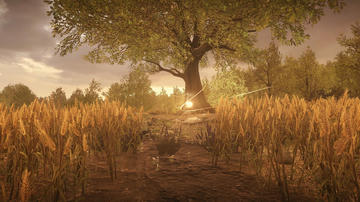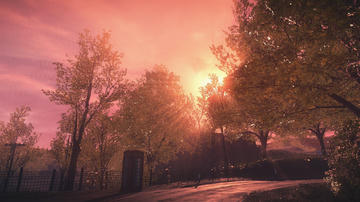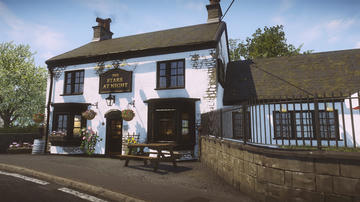Everybody’s Gone to the Rapture
The Chinese Room, 2015

In 2012, The Chinese Room made a name for themselves with the lovely Dear Esther, an experimental new way to tell stories in games. Now this talented team demonstrate their exceptional craft with a beautiful and elegiac story about the end of the world.
Everybody’s Gone to the Rapture is not a game. It’s not a walking simulator either, the reductive label given to games that lack action and focus on story and exploration. Despite Rapture being labelled both these things in the gaming press, I disagree with both. For me, Rapture is an interactive drama, more akin to theatre or a radio play. It’s from this perspective that I’m reviewing the ‘game’ as anything else feels disingenuous.
Story
Rapture tells a story of the end of the world, or at least the end of the world for Yaughton, a fictional Shropshire village. Set in the 1980s, the player finds themselves exploring the empty village to try and uncover why everybody is missing. And here lies the first conundrum: if the world has ended and there’s no-one left, who is the player and what are you doing there?
I start by the locked gates to Valis, the Yaughton observatory. I may wander where I please but the game is encouraging me to investigate a small hut outside the observatory, the door slightly ajar. From within come strange sounds of static and a voice announcing a string of numbers, while in the distance a phone rings. Exploring this hut introduces two interactive items, a radio and computer. I turn on the radio and I hear someone named Kate Collins. She tells anyone listening that “the event has left strange markers” and that “the answers are in the light”.
Who is Kate? What event is she talking about? What are these markers, and what answers will I find? This is the mysterious setup and as the player it’s up to me to uncover what happened.
Gameplay and mechanics
Walking into the village of Yaughton takes me through a side gate where I find the first marker. A light shimmers gently, stationary a few feet off the ground. Moving the mouse from left to right finds a sweet spot that causes the light to expand and create swirling ribbons of light. The landscape darkens, stars come into view and the flickering ghosts of people appear, rendered as particles of light. I can hear them talk to each other: it’s a replay of something that happened in the past. Kate is there, and a man named Stephen, and they are confronting an older man, Graeme. The dialogue is both mysterious and revealing and my curiosity is sparked. What happened to all these people?

I wander on and find myself in the village. A strange ball of energy and light is moving around the village. I follow it to see where it leads and find myself with another interaction as the name “Jeremy” is shown on screen. It becomes clear that this ball of light somehow represents Jeremy and by following it and uncovering more story, I discover who Jeremy was and what happened to him.
As I progress, five more orbs of light are discovered, and they lead us through the stories of five more people. I noticed that each orb moved slightly differently, perhaps an echo of the personality of who they represent. It’s this subtle attention to detail that reveals the depth of thought and craftsmanship that went into crafting the story.
Each cutscene revealed, each snippet of dialogue, each radio discovered: they all give away small chunks of what happened and the story is filled with both melancholy and menace. Telling the story through these non-linear revelations is clever and mysterious, and I was asking questions of it right until the very end.

Emotional heart
That’s enough about the plot and gameplay because revealing anything else would undermine the whole experience. You must play this for yourself if you want the full story; instead I’m going to talk about how this game made me feel, because it’s the most emotional experience I’ve ever had in a ‘game’ and one that will stay with me for a long time.
Rapture is a story about love.
There are different kinds of love explored throughout this work: the love of parents for their children, the love of a couple for each other, the love of a priest for his parishioners. But above all, this story is about the love we share with those we are close to: how we become better people when we give our love away, and how love is the binding force of humanity.
I touched the lives of many characters during this experience, and I believed in all of them. It’s rare that I can relate to characters in a game this deeply, and it’s even rarer to do so when the characters don’t even have a body or a face. It’s testament to the exceptional voice acting of a stellar cast that I became completely absorbed in the stories of these lost people and their fates. Some of the revelations are so deeply felt, and so moving, that I cried many times during my six hour play-through, and by the end I was an emotional wreck.

I particularly loved the voice work for Kate (played by Merle Dandridge, famous for Alyx Vance in Half-Life 2), Stephen (Oliver Dimsdale) and Jeremy (Jamie Ballard). I also had fun spotting great British stalwarts Victor McGuire as Charlie, and Aimee-Ffion Edwards as Rachel. Indeed, there is something about Rapture that evokes some of the tone of the wonderful TV show Detectorists, so it felt especially fitting to have Aimee playing roles in both.
But even though these characters are written and acted extremely well, it’s the music of this experience that packs the most powerful punch. Each of the main six characters has their own theme, which plays during their story revelations. There is also some clever dynamic music at work that seems to follow me around, picking up on the notes of a finished character theme.
Composer Jessica Curry has written and produced such an amazing score for Rapture, that the experience would be much less powerful without it. The soaring choral compositions stood the hairs up on my neck: indeed, the music of the opening credits brought tears and I hadn’t even started the game yet! I can’t rate the music highly enough: it’s one of the most exceptional scores ever written for a game and full of beautiful compositions in its own right. I was absolutely delighted for The Chinese Room when Rapture won both the 2016 Bafta Music award and the 2016 Bafta Audio Achievement award.

I hate to mention any negatives about Rapture. In nearly every respect it’s an amazing and memorable experience. But the one thing that makes it slightly frustrating is the glacial walking pace of the player character. It takes absolutely ages to get anywhere. The pace is deliberate, allowing for time and space to process each snippet of story, but at times it became painful that I couldn’t quickly backtrack to revisit a small detail, or try a different path. It’s possible to move faster by holding down shift as you walk, but it’s still not quite enough. Personally I’d make the pace a bit quicker, but who am I to second guess The Chinese Room’s intentions?
Final thoughts
Rapture is an exceptional piece of art. Even though it’s presented as a game, it shouldn’t be judged on that basis as I previously noted. The characters who drive the story are fully realised and completely believable. The story asks timeless questions about what it means to be human. The production values are sky-high, with a gorgeously realised world and spine-tingling music.
It’s fitting that 3 Baftas were awarded to Rapture – this sort of exceptional work is rare and I thank The Chinese Room for giving me this experience. If only more games strove for this kind of beauty rather than simply giving us bigger guns, the gaming industry would be a much better place. But for now, I simply celebrate Rapture as the pinnacle of interactive drama and can’t wait to see what this talented team will produce next.